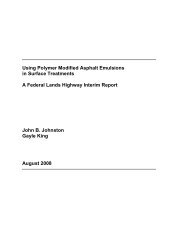journal - TSP2
journal - TSP2
journal - TSP2
Create successful ePaper yourself
Turn your PDF publications into a flip-book with our unique Google optimized e-Paper software.
Regional Partnerships Launch PR<br />
Outreach on Preservation Needs<br />
By Larry Galehouse, P.E.<br />
Perhaps the single largest barrier facing the adoption<br />
of pavement preservation programs across the<br />
country is public support. We should pay heed to<br />
the quote from the 55th Speaker of the U.S. House<br />
of Representatives, Tip O’Neill, “all politics is local.” Every<br />
decision begins at the local level and with public involvement.<br />
That’s why we must be able to explain the value of<br />
pavement preservation now, compared with the cost of<br />
major rehabilitation or reconstruction later. The public<br />
needs to understand the importance of shifting from<br />
prioritizing the worst roads first to the best roads first. It’s<br />
about preserving their financial investment.<br />
The members of the AASHTO TSP•2 Regional Pavement<br />
Preservation Partnerships understand the urgency for<br />
educating the public about the value of pavement preservation.<br />
They have funded a public relations consultant to launch<br />
a media campaign to generate news coverage designed to<br />
change public thinking about the need to safeguard our roads<br />
from deterioration throughout the United States.<br />
An issue of such magnitude will only gain traction<br />
through aggressive and persistent contact with reporters<br />
and editors who cover transportation infrastructure<br />
and business issues. The media cannot be counted on to<br />
discover the story on their own or to recognize its relevance.<br />
Instead the agencies and preservation industry need to be<br />
the catalyst for media attention.<br />
The NCPP soon will distribute<br />
information through two<br />
websites, www.tsp2.org and<br />
www.pavementpreservation.org<br />
NOT AN EASY SELL<br />
Pavement Preservation will not be an easy media sell,<br />
considering the range of other compelling issues on the<br />
media’s radar. Despite its importance to the national and<br />
local economies, preserving our infrastructure will compete<br />
with other “crisis” issues, including our failing health care<br />
and education systems, just to name two. The media must<br />
be convinced that our crumbling infrastructure warrants<br />
the same attention and has as much impact on the economy.<br />
In order for the media campaign on pavement<br />
preservation to succeed, interested stakeholders must<br />
speak with a unified voice, and have a common message.<br />
The NCPP soon will distribute information through two<br />
websites, www.tsp2.org and www.pavementpreservation.<br />
org. The message is crafted around principal reasons<br />
why pavement preservation is important: greater cost<br />
savings, increased economic competitiveness, improved<br />
safety, higher employment, long term sustainability, green<br />
conservation and reduced traffic congestion.<br />
Guaranteeing stable, long-term financing for pavement<br />
preservation can only be achieved if public awareness<br />
grows. The AASHTO TSP•2 produced a 5-minute video that<br />
carries the message. You can view and download the video<br />
at www.tsp2.org.<br />
CIR IN THE BAY AREA<br />
In California, the NCPP recently worked with<br />
Sonoma County, the City of Napa, and the Metropolitan<br />
Transportation Commission — a regional planning<br />
organization for roads and transit in the San Francisco<br />
Bay Area — to implement and market a Climate Initiative<br />
Outreach Program featuring cold in-place recycling (CIR).<br />
Two workshops were held at the MTC offices in Oakland.<br />
The first workshop included an overview session of CIR<br />
which highlighted its advantages, such as lower initial<br />
cost, reduced energy consumption, and fewer greenhouse<br />
gas emissions. After the overview session a field trip was<br />
made to the City of Napa to view first hand an active CIR<br />
operation being performed by Pavement Recycling Inc.<br />
Several months later, the second workshop was presented<br />
to the technical staffs of from 109 Bay Area public works<br />
agencies, the focus of which was CIR design engineering and<br />
construction process. Experts discussed project selection, mix<br />
and thickness design, construction and inspection procedures.<br />
Testimonials also were given by local agency officials about<br />
past experiences with CIR operations and performance.<br />
A complete record of both CIR workshops along<br />
with a video presentation is available online at<br />
www.pavementpreservation.org/conferences.<br />
NEW GUIDANCE ON PROPRIETARY PRODUCTS<br />
The FHWA issued a guidance memorandum concerning<br />
the use of patented and proprietary products. This<br />
memorandum should be of particular interest to state DOTs<br />
because it clarifies the use and deployment of such products.<br />
The updated guidance is posted at<br />
www.fhwa.dot.gov/programadmin/contracts/011106qa.<br />
cfm.<br />
Galehouse is executive director, National Center for Pavement<br />
Preservation, Okemos, Mich.<br />
CENTERS<br />
Summer 2012 pavement preservation <strong>journal</strong> 37
















